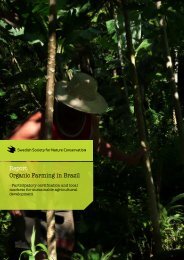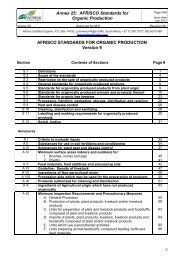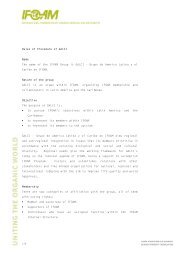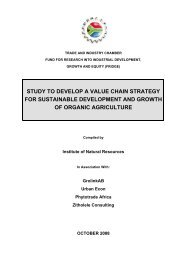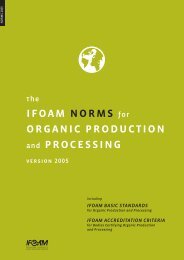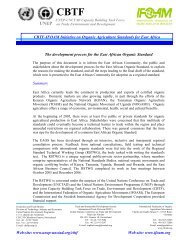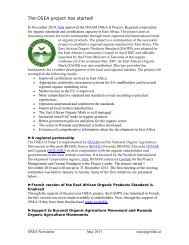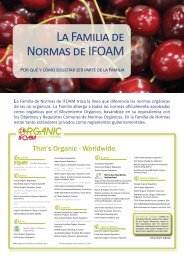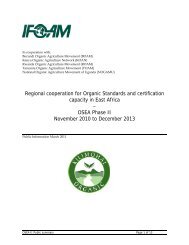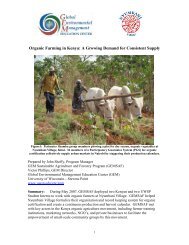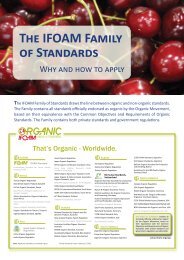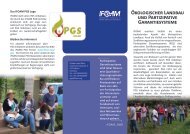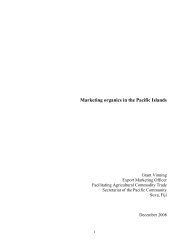OSEA I Project Report - ifoam
OSEA I Project Report - ifoam
OSEA I Project Report - ifoam
You also want an ePaper? Increase the reach of your titles
YUMPU automatically turns print PDFs into web optimized ePapers that Google loves.
DEVELOPMENT OF A REGIONAL ORGANIC AGRICULTURE STANDARD IN EAST AFRICA 2005-2007<br />
Faso, Ethiopia, Ghana, Malawi, Nigeria, South Africa, Sudan and Zambia. African Institutions<br />
such as COMESA, NEPAD and the African Development Bank also participated in the conference.<br />
During the project period, and partly as a result of the inspiration from the project,<br />
COMESA has embarked on a number of projects related to organic.<br />
The EAOPS also received public attention, through the media and the cooperating organization.<br />
It has been presented at several international events such as<br />
– the Biofach trade fair, Nuremberg, February 2007<br />
– the WTO Committee on Trade and Environment, Geneva, 2 May 2007<br />
– the IFOAM conference on values in regional food, Germany, August 2007<br />
– the CBTF Symposium, “Environmental Requirements and Market Access: Turning<br />
Challenges into Opportunities”, Geneva, October 2007<br />
– the seventh meeting of the International Task Force on Harmonization and Equivalence<br />
in Organic Agriculture, Bali, December 2007<br />
IMPLEMENTATION<br />
PROJECT MANAGEMENT<br />
Gunnar Rundgren (Grolink AB) was contracted by IFOAM as the project leader, and as such<br />
oversaw all activities. Patricia Wangong’u from IFOAM acted as a regional coordinator and<br />
Anne Boor as the IFOAM coordinator. The heads of the three NOAMs—Eustace Kiarii (KOAN),<br />
Jordan Gama (TOAM) and Moses Muwanga (NOGAMU)—were part of the <strong>OSEA</strong> Advisory<br />
Committee, which guided and monitored the project. Eva Mattsson, Grolink AB, was the consultant<br />
in charge for standards development, field testing and inspection protocol. Samuel<br />
Ndungu, KOAN, coordinated the consumer survey, assisted by staff from the three NOAMs.<br />
The NOAMs also implemented some of the project activities directly, in particular those related<br />
to consumer awareness. The project also benefited from input from the CBTF project, in particular<br />
from Sophia Twarog (UNCTAD) and Asad Naqvi (UNEP).<br />
CHALLENGES<br />
When the project was planned, the EAC had only three members: Kenya, Tanzania and Uganda.<br />
However, in 2006 Rwanda and Burundi sought membership in the EAC, and the project tried<br />
to integrate them in the major activities, e.g., the standards working group. Budget constraints,<br />
however, didn’t allow for their full integration.<br />
Obviously there have also been problems in the implementation. The main obstacle initially<br />
was resistance in one of the national standards bodies to the private-sector-led initiative. It<br />
took major efforts to convince them that the model chosen was the right one.<br />
There was also certain scepticism from the private sector towards government involvement and<br />
to what extent the East African Community indeed was the best framework for governance of<br />
the standard. While there are still some reservations, it was ultimately agreed that this framework<br />
gave the standard credibility and that it was open enough to allow the national organic<br />
agriculture movement to influence the standards in the future.<br />
23



